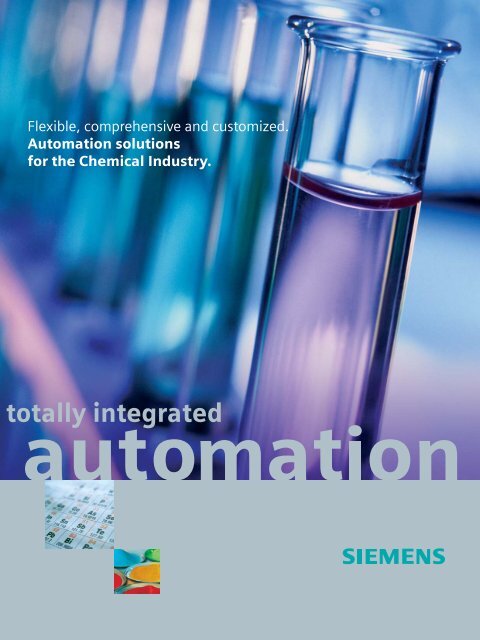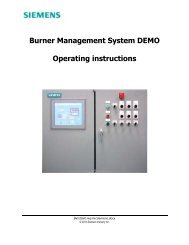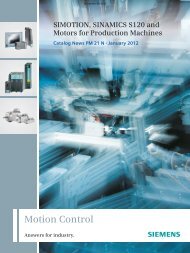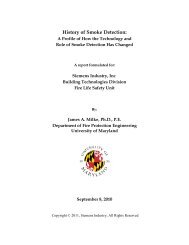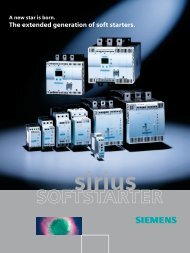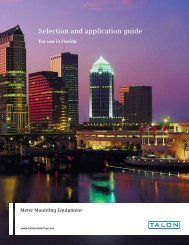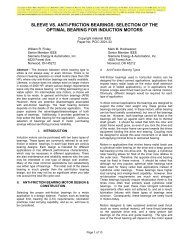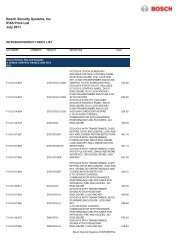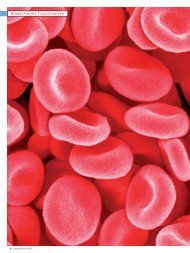totally integrated - Siemens Industry, Inc.
totally integrated - Siemens Industry, Inc.
totally integrated - Siemens Industry, Inc.
Create successful ePaper yourself
Turn your PDF publications into a flip-book with our unique Google optimized e-Paper software.
Flexible, comprehensive and customized.<br />
Automation solutions<br />
for the Chemical <strong>Industry</strong>.<br />
<strong>totally</strong> <strong>integrated</strong>
Your competent partner in<br />
automation<br />
<strong>Siemens</strong> – a name recognized all over the world. A name<br />
that stands for innovation, customer orientation and a<br />
global competitiveness. Not only for 400,000 employees<br />
and millions of customers, but also for hundreds of thousands<br />
of suppliers and partners in more than 190 countries.<br />
Chemicals are part of the fabric of life – from the ingredients<br />
in our shower gels and the shoes on our feet, to the colors<br />
that surround us and the electronic devices that make life<br />
so convenient. Chemicals help to make our world a safer,<br />
more comfortable, more pleasant place to live.<br />
It also stands for a unique range of products, systems and<br />
solutions.<br />
<strong>Siemens</strong> also embodies the timeless vision of its founder,<br />
Werner von <strong>Siemens</strong>: “Progress serving mankind”.<br />
With more than 50,000 employees in 70 countries, <strong>Siemens</strong><br />
Automation and Drives (A&D) is one of the largest groups<br />
within <strong>Siemens</strong> AG. As a technology and market leader in<br />
automation and drives technology, we are continually<br />
making rapid advances in this field – and setting new<br />
standards again and again.<br />
<strong>Siemens</strong> A&D offers a unique, complete range of innovative<br />
products, systems and solutions. Totally Integrated Automation<br />
(TIA) and Totally Integrated Power (TIP) form the<br />
backbone of our portfolio – and the basis for customerspecific<br />
solutions in the field of automation and energy<br />
distribution.<br />
2
<strong>Industry</strong> Suite Chemicals –<br />
the customized solution for you<br />
In the <strong>Industry</strong> Suite Chemicals, the worlds of automation<br />
and power engineering merge into one comprehensive and<br />
modular offer for your needs – including the required services<br />
across the entire life-cycle of your plant.<br />
<strong>Industry</strong> Suit<br />
Totally Integrated Automation<br />
Optimization of the complete workflow<br />
With Totally Integrated Automation, <strong>Siemens</strong><br />
is the only supplier of an <strong>integrated</strong> range<br />
of products and systems for automation of<br />
chemical plants – from the field level and<br />
production control level to the enterprise<br />
level. Your benefit: considerably lower lifecycle<br />
costs for the plant, shorter time-tomarket<br />
and consequent improvement of your<br />
competitiveness.<br />
Process know-how<br />
On the basis of our comprehensive industry know-how, we<br />
implement solutions that guarantee optimum fit and maximum<br />
process transparency for your plant – while requiring<br />
a minimum of manpower.<br />
Tailor-made energy concepts<br />
With our solutions in the field of energy supply, we make a<br />
decisive contribution to the smooth, economical and environmentally<br />
friendly operation of your plant.<br />
Process optimization by means of MES solutions<br />
Our MES solutions are essential to enable you to optimize<br />
your processes throughout the plant. They ensure <strong>integrated</strong><br />
data transfer – vertically from the field to the enterprise level<br />
and horizontally from your suppliers to your customers.<br />
3
industry<br />
Basis of the <strong>Industry</strong> Suite Chemicals: Totally Integrated<br />
Automation and Totally Integrated Power – plus our<br />
comprehensive know-how in your industry.<br />
e Chemicals<br />
Totally Integrated Power<br />
Power management and distribution<br />
from a single source<br />
On the basis of Totally Integrated Power (TIP),<br />
we implement <strong>integrated</strong> solutions for power<br />
distribution across all chemical production<br />
units and industrial buildings, from the medium-voltage<br />
supply to the outlet. Equipped<br />
with the same communication standards as<br />
Totally Integrated Automation, all resources<br />
– for automation, power distribution, energy<br />
management and building automation – can<br />
be seamlessly <strong>integrated</strong> and comprehensive<br />
solutions can be implemented in your plant.<br />
Drive solutions<br />
Innovative technology, precisely coordinated components<br />
and comprehensive engineering know-how are your<br />
guaranty that our drive solutions will meet even your highest<br />
requirements – in terms of performance, torque, dynamics,<br />
availability, diagnostics capability and cost effectiveness.<br />
Life-cycle services<br />
Our comprehensive range of services is an efficient lever<br />
ensuring continuous optimum performance of your plants.<br />
With our solutions we cover the entire life-cycle of your<br />
plants – from planning and implementation to modernization<br />
and maintenance.<br />
System integration<br />
In addition to our own established competence and expertise<br />
in the field of system integration we work closely together<br />
with <strong>Siemens</strong> Solution Partners. The result: a global network<br />
of automation professionals that you can use to your advantage.<br />
Throughout the world, the quality seal of <strong>Siemens</strong><br />
Solution Partners has long been a guarantee for world-class<br />
services.
Content<br />
Your Partner in Automation .............................. 2<br />
<strong>Industry</strong> Suite Chemicals .................................. 3<br />
Totally Integrated Automation .......................... 4<br />
Process Competence ......................................... 6<br />
Process Control System..................................... 8<br />
Manufacturing Execution System ..................... 13<br />
Field Devices .................................................... 14<br />
Industrial Communication ................................ 16<br />
Drive Systems .................................................. 18<br />
Process Instruments and Analytics ................... 20<br />
Industrial Controls ............................................ 22<br />
References ....................................................... 24
Improve your competitiveness<br />
in your industry.<br />
With Totally Integrated Automation<br />
With Totally Integrated Automation (TIA), <strong>Siemens</strong> offers a unique,<br />
<strong>integrated</strong> portfolio of products and systems for the implementation of<br />
automation solutions. TIA fulfills your objectives with <strong>Siemens</strong> technology<br />
and products providing an impressive and unique level of integration.<br />
This not only reduces the cost of interfaces, but also ensures maximum<br />
transparency across all levels – from field, through the production level<br />
to the corporate management level. For all processes in the Chemical<br />
<strong>Industry</strong> from bulk chemicals, specialty chemicals to consumer products.<br />
It goes without saying that you benefit with TIA throughout the life-cycle<br />
of your plant – from the product design phase, through the operation to<br />
the modernization. With a high level of consistency and integration of<br />
our products and systems, we provide you a high security of investment<br />
– avoiding unnecessary interfaces in the system.<br />
On the basis of Totally Integrated Automation,<br />
we implement solutions that are perfectly<br />
tailored to your special requirements in the<br />
Chemical <strong>Industry</strong> and which are characterized<br />
by their excellent integration. In this way,<br />
TIA makes an essential contribution to the<br />
optimization of your production processes.<br />
ERP<br />
Enterprise<br />
Resource<br />
Planning<br />
Ethernet<br />
Totally Integrated<br />
Automation<br />
MES<br />
Manufacturing<br />
Execution<br />
Systems<br />
Ethernet<br />
Production<br />
Order<br />
Management<br />
Production<br />
Operations<br />
Recording<br />
Material<br />
Management<br />
Equipment<br />
Management<br />
SIMATIC IT Framework<br />
Production Modeler<br />
Plant<br />
Information<br />
Management<br />
Detailed<br />
Production<br />
Scheduling<br />
Control<br />
SIMATIC NET<br />
Industrial<br />
Communication<br />
SINAUT Telecontrol<br />
System<br />
SIMATIC<br />
Software<br />
SIMATIC Controllers/<br />
Automation System<br />
PROFINET<br />
SIMATIC<br />
Sensors<br />
SENTRON<br />
Circuit Breakers<br />
SIMATIC PCS 7<br />
Process Control System<br />
Industrial<br />
Ethernet<br />
Safety Integrated<br />
PROFIBUS<br />
PC-based Automation<br />
Field Instrumentation/<br />
Analytics<br />
AS-Interface<br />
KNX/EIB<br />
Building<br />
Technology<br />
HART<br />
GAMMA instabus<br />
Micro Automation and<br />
Actuator-Sensor Interface Level<br />
ECOFAST IP65<br />
Distributed<br />
Automation System<br />
SIMOCODE pro<br />
Motor Management<br />
System<br />
SIRIUS<br />
Soft<br />
Starter<br />
SIMATIC<br />
Distributed I / O<br />
PROFIBUS PA<br />
4
The answer to growing demands<br />
Productivity, flexibility, safety and resource efficiency are the key to<br />
economic success in the production processes of chemical plants. Only<br />
companies that can successfully master these challenges can meet the<br />
market demands for short delivery times, ensured quality and prices that<br />
are always in line with the market.<br />
You know the factors required to achieve higher productivity in chemical<br />
plants: a maximum degree of automation, consistent quality – and, last<br />
but not least, the highest possible availability.<br />
Thanks to the system-oriented engineering<br />
environment as well as the <strong>integrated</strong> communication<br />
and diagnostics options of TIA,<br />
your plant will benefit in every phase of the<br />
life-cycle. What is more, the consistency in<br />
ongoing product innovation offers you<br />
maximum security of investment in case of<br />
modernization.<br />
Product Specification<br />
Management System<br />
Advantages for plant operation<br />
The <strong>Siemens</strong> range of products and solutions is specifically tailored to<br />
your requirements. Top priority is placed on integration and openness –<br />
in all key areas from automation to drives right up to process instrumentation.<br />
These solutions are based on proven industrial standards and are<br />
optimized to achieve the highest possible degree of economic efficiency<br />
throughout the entire life-cycle of a plant.<br />
Advantages for system integration<br />
Growing pressure on the production side, ever shorter product life-cycles,<br />
rising production demands and an ever greater complexity. On the one<br />
hand, the end customer demands for you as a system integrator are<br />
immense. On the other hand you require solutions, which let you execute<br />
and engineer your customer projects more quickly, precisely and economically<br />
– from the design to commissioning.<br />
Totally Integrated Automation is the foundation for:<br />
shorter time-to-market from the planning to the delivery<br />
higher system availability and flexibility<br />
improved quality of engineering<br />
shorter and easier engineering and commissioning<br />
cost savings in projects<br />
Laboratory Information<br />
Management System<br />
Advantages for the EPC<br />
As an EPC, you must respond to a continuously rising competitive pressure.<br />
At the same time, more is being expected of your solutions all the time<br />
and the demands that you must meet are becoming increasingly complex.<br />
SIMATIC HMI<br />
Human Machine<br />
Interface<br />
SIMOTION<br />
Motion Control<br />
System<br />
SINUMERIK<br />
Computer<br />
Numeric Control<br />
Totally Integrated Automation is the foundation for:<br />
standardized interfaces between E&I engineering packages<br />
highest availability of plant equipment<br />
lower design and engineering costs<br />
faster project execution<br />
higher productivity and flexibility<br />
Drive Systems/<br />
SINAMICS<br />
SINAMICS<br />
SIMODRIVE<br />
SINAMICS<br />
5
Competence for the processes in the Chemical <strong>Industry</strong><br />
To ensure economic success in the chemicals business, you<br />
need top productivity, highest flexibility, maximum safety<br />
and the efficient use of resources in all your production<br />
processes. This is the only way to meet the demands for fast<br />
delivery, high and constant quality, and competitive prices.<br />
Typical process units in chemical plants<br />
Reaction<br />
The reaction process is at the heart of chemicals production,<br />
and the greater the efficiency and performance of the catalyst,<br />
the better the product yield and quality. To ensure the best<br />
possible results, key process parameters such as temperature,<br />
pressure and flow must be controlled with great precision.<br />
Heat Exchange<br />
When process media are being warmed or cooled, it’s crucial<br />
for heat exchangers to quickly and precisely reach the right<br />
temperature. At the same time, of course, it’s important to<br />
prevent any contamination or unnecessary energy loss.<br />
Extraction<br />
Using the best possible extraction agents, together with<br />
seamless integration of heat with downstream columns,<br />
brings long-term cost savings in extraction while maximizing<br />
product quality and minimizing environmental impact.<br />
Distillation<br />
Two key parameters determine the economic efficiency of<br />
the distillation process: how much energy is used for vaporization<br />
and condensation, and – as with heat-sensitive<br />
substances, for example – whether environmental conditions<br />
can be completely controlled.<br />
Absorption<br />
Successful, efficient absorption of gaseous product mixtures<br />
depends on selecting the right absorbing agent and controlling<br />
all process parameters. High process and product<br />
quality can only be achieved when all factors are optimally<br />
combined and coordinated.<br />
6
Tailored to the demands of the Chemical <strong>Industry</strong>:<br />
<strong>Siemens</strong> automation solution with SIMATIC PCS 7<br />
SIMATIC® PCS 7 is the <strong>Siemens</strong> distributed control system<br />
(DCS), based on TIA, using standard hardware and software<br />
components and can easily be connected to the Manufacturing<br />
Execution System level (MES).<br />
SIMATIC PCS 7 benefits for the Chemical <strong>Industry</strong>:<br />
One common engineering tool PCS 7-ES for the complete<br />
process – saves engineering time<br />
One common visualization of all data in all PCS 7 operator<br />
stations with a standard alarm visualization – reduces<br />
production downtimes<br />
Field instrumentation, motors and drives are fully <strong>integrated</strong><br />
in TIA and PCS 7, relative to engineering, operation, maintenance<br />
and diagnostics<br />
Pre-configured function blocks and libraries, adapted to<br />
different industry requirements, simplify configuration<br />
High performance automation systems with SIMATIC<br />
S7-400 controller on Ethernet up to 1 Gbps. At the field<br />
bus level, PROFIBUS DP and PA is provided<br />
Redundant controller and PROFIBUS communication for<br />
high-availability processes keep the process running and<br />
reduce production downtimes<br />
Safety Integrated with the PROFIsafe profile on a single<br />
PROFIBUS cable, using one controller and one engineering<br />
tool. This saves time and the expense of additional<br />
components<br />
Standard and fail-safe remote I/O modules on PROFIBUS DP<br />
ensure reliable data transmission and diagnostics.<br />
SIMATIC ET 200M remote I/O modules provide a large<br />
variety of digital and analog input and output channels.<br />
8
Flexibility and scalability – from a small laboratory<br />
system up to distributed client/server architectures<br />
As a result of its modular and open architecture that is based<br />
on selected hardware and software components from the<br />
standard SIMATIC range, SIMATIC PCS 7 can be applied<br />
effectively in small and large plants. It allows easy expansion<br />
or system modification (online) to enable customers to meet<br />
the changing production requirements of their facility.<br />
SIMATIC PCS 7 is scalable from a small single system consisting<br />
of approx. 160 measuring points (motors, valves, PID controllers),<br />
such as might be used for a laboratory system or<br />
a pilot plant, up to a distributed multi-user system with<br />
client/server architecture and approx. 60,000 measuring<br />
points, such as might be used for automation of a very large<br />
production plant or for groups of connected facilities.<br />
Depending on the plant’s requirements, the operator and<br />
the planning engineer can<br />
Select from various automation systems with graded<br />
performance characteristics<br />
Use distributed (remote) or central I/Os step-by-step<br />
Layout an optimum architecture for the operator system:<br />
from single-user standalone stations up to distributed<br />
multi-user system<br />
Select the engineering and runtime system software<br />
according to the size of the system (scaled by process<br />
objects)<br />
Configure communication networks and determine network<br />
components to support required levels of redundancy<br />
and availability<br />
Extend the functionality of the operator stations by<br />
adding various hardware and software modules, e.g. using<br />
SIMATIC BATCH or with a standalone, redundant archive<br />
server<br />
Integrate applications connecting SIMATIC PCS 7 to legacy<br />
systems and the IT system.<br />
Stand-alone systems<br />
Production facilities<br />
Various plants of a production site<br />
Scalable from small applications<br />
(~160 process objects) …<br />
… to the distributed system in client/server<br />
(~ 60,000 process objects)<br />
9
SIMATIC PCS 7:<br />
the distributed control system in Totally Integrated Automation<br />
Open DCS for the future<br />
SIMATIC PCS 7 is based on modular SIMATIC hardware and<br />
software components. The innovative process control system<br />
is fully harmonized with TIA. It is flexible, expandable and<br />
open for future enhancements through the use of standard<br />
interfaces with long-term stability.<br />
SIMATIC PCS 7 consistently applies state-of-the-art, powerful<br />
technologies together with internationally established<br />
industrial standards such as IEC, XML, PROFIBUS, Ethernet,<br />
TCP/IP, OPC, ISA S88 and ISA S95, to mention just a few.<br />
The openness of SIMATIC PCS 7 covers all levels and applies<br />
equally to automation systems, process I/Os and field devices<br />
as to operator and engineering systems, industrial communication<br />
networks or the SIMATIC IT framework. Furthermore,<br />
the system offers completely <strong>integrated</strong> function blocks for<br />
motors, valves and control devices.<br />
Common and <strong>integrated</strong> system<br />
SIMATIC PCS 7 can be used on its own or in combination<br />
with Motion Control and further SIMATIC components.<br />
High performance, flexibility and ease-of-use, together with<br />
common data management, communication and configuration,<br />
guarantee that the typical demands placed on a process<br />
control system can be met and exceeded by SIMATIC PCS 7:<br />
Simple and safe process control<br />
Intuitive operation and visualization<br />
Powerful system engineering tools with a common interface<br />
simplify the engineering and save money throughout<br />
the entire plant life-cycle<br />
Online modifications possible throughout the system<br />
System openness at all levels makes plant enhancements<br />
easy<br />
Redundancy at all levels makes high availability scalable<br />
to your needs<br />
Flexibility and scalability simplifies plant improvements<br />
Automation solutions avoid any injury to humans and<br />
damage to equipment and provide high process availability<br />
at the same time<br />
Comprehensive fieldbus integration makes the connection<br />
of field devices easy and optimizes the handling<br />
Direct interfacing to the IT system opens the DCS.<br />
10
Maximum plant availability, with overall<br />
redundancy through all levels<br />
Availability is one of the most important criteria in a chemical<br />
production, and consequently the availability of the automation<br />
solution itself plays a key role in the economical effectiveness<br />
of the plant. On the one hand the capital investment<br />
for a chemical plant is extremely high, and on the other<br />
hand, any production loss due to shut-down and start-up<br />
operations can imply huge economical loss. Plant shut downs<br />
must then be avoided as far as possible – with periods usually<br />
reaching from once a year to less than one shut-down every<br />
5 years for example for a steam cracker.<br />
To guarantee the highest availability of the automation<br />
system, all system facettes have to be taken into consideration:<br />
starting from the controllers up to the operator level<br />
and including the whole plant communication networks,<br />
from the field to the production control level.<br />
optionally with<br />
redundant<br />
power supply<br />
Redundant OS clients and<br />
SIMATIC BATCH clients<br />
OS-LAN (Ethernet) segment 1 OS-LAN (Ethernet) segment 2<br />
OS server<br />
BATCH server<br />
Double redundant Industrial Ethernet plant bus<br />
S7-400H<br />
high-availability automation system<br />
ET 200M<br />
ET 200M<br />
BATCH server<br />
Actuator/Sensor<br />
Depending on each of your specific requirements, environmental<br />
and vulnerability aspects of your plant, TIA and<br />
SIMATIC PCS 7 can provide you the best adequate redundancy<br />
configuration. Based on a flexible, comprehensive concept<br />
we can offer up to the highest availability levels, seamlessly<br />
integrating all plant levels, from the sensor/actuator to the<br />
control room – while responding to the harshest Chemical<br />
<strong>Industry</strong> environment conditions.<br />
Operator stations (OS) and batch clients<br />
Operator station bus level (terminal bus):<br />
• Use of standard off-the-shelf components (switches,<br />
cards etc.)<br />
• <strong>Inc</strong>reased availability, with single ring architecture or<br />
terminal bus split into several LAN segments<br />
Multi-monitor operator stations, up to 4 monitors per<br />
client<br />
Batch client/server architecture, permitting up to<br />
32 OS/SIMATIC BATCH clients to access the data of a<br />
single OS/Batch server.<br />
OS- and batch servers<br />
Redundant OS server, with automatic and transparent<br />
switch-over of the OS client stations, between primary<br />
and backup server<br />
Redundant batch server<br />
Process data can be archived on each OS server or can be<br />
stored on a standalone, and optionally redundant, plantwide<br />
historian<br />
Critical OS/SIMATIC BATCH running as a background task<br />
on the server are continuously monitored for faults that<br />
would result in a client switchover<br />
Process data and alarm messaging archives can be automatically<br />
synchronized when a partner server is returned<br />
to service, thus eliminating data gaps.<br />
Redundant PROFIBUS DP<br />
Redundant<br />
DP/PA Link<br />
ET 200M<br />
fail-safe<br />
PROFIBUS PA<br />
Y-Link<br />
Connection of<br />
non-redundant<br />
PROFIBUS DP devices<br />
on redundant<br />
PROFIBUS DP<br />
11
Automation system and plant bus<br />
Dedicated Ethernet LANs for client-server and server-server<br />
communication<br />
Communication between automation systems, engineering<br />
stations, operator systems over Industrial Ethernet plant<br />
bus, at up to 1 Gpbs; both line or ring topology possible<br />
<strong>Inc</strong>reased availability with redundant ring architecture<br />
Redundant, high-availability S7-400H automation systems,<br />
connected to plant bus over dedicated Ethernet communications<br />
processor (CP)<br />
Optionally, for even higher level of redundancy, each of<br />
the 2 automation station CPUs can be connected via two<br />
separated CPs, thus each CPU to be connected simultaneously<br />
to both networks of redundant plant bus architecture.<br />
Redundancy at the distributed I/O level<br />
Multiple PROFIBUS DP segments can either be connected<br />
to distributed I/Os via the onboard PROFIBUS DP interfaces,<br />
or using additional PROFIBUS communications processor<br />
modules<br />
Using the ET 200M distributed I/O system, redundancy can<br />
be extended down to the I/O module level, whereby a<br />
single sensor/actuator can be connected to redundant I/O<br />
modules<br />
Using redundant controllers, each ET 200M unit is connected<br />
to the redundant PROFIBUS DP segments.<br />
Redundancy of field devices<br />
Intelligent field devices on PROFIBUS PA fieldbus segment<br />
can be connected via a redundant DP/PA link<br />
Non-redundant PROFIBUS DP devices can also be connected<br />
to a redundant PROFIBUS DP network segment, using our<br />
Y-link.<br />
Asset Management for systematic automation and<br />
maintenance of plants<br />
<strong>Siemens</strong> offers an efficient solution for plant maintenance:<br />
SIMATIC PCS 7 Asset Management. The particular highlight<br />
here is that the new feature is simply <strong>integrated</strong> into the<br />
SIMATIC PCS 7 process control system. No additional hardware<br />
or software tools are required. Plant operators and maintenance<br />
engineers use the same SIMATIC PCS 7 tools and<br />
operator interfaces with information that has been filtered<br />
and prepared for the relevant application area.<br />
Complete integration of field devices<br />
SIMATIC PCS 7 is optimized for integration of distributed field<br />
equipment into the process control systems, and is based<br />
on PROFIBUS technology. It supports redundancy and failsafe<br />
architectures, in addition to online expansions, and can<br />
be used in standard environments or in hazardous areas.<br />
The plant can be equipped with conventional SIMATIC ET 200<br />
distributed I/Os, or with state-of-the-art, intelligent field<br />
devices.<br />
12
SIMATIC IT: the basis for increased productivity<br />
Maintaining a highly flexible and efficient production process<br />
allows chemical manufacturers to maintain market position<br />
and deal with competition. SIMATIC IT is the Manufacturing<br />
Execution System from <strong>Siemens</strong>. It enables chemical manufacturers<br />
to optimize production. This is possible by bridging<br />
the gap between business systems and the control level and<br />
by synchronizing operations all along the production and<br />
product life-cycle. SIMATIC IT offers <strong>integrated</strong> quality assurance,<br />
product specification management, tracking and tracing<br />
and comes with functionality specifically tailored to the<br />
needs of the Chemical <strong>Industry</strong>, complying ISA-95 standard.<br />
MES – Manufacturing Execution System SIMATIC IT<br />
SIMATIC IT links the plant floor with the business systems<br />
and increases plant visibility. Due to its modular, object<br />
oriented, open and scaleable architecture, SIMATIC IT enables<br />
customers to standardize repeatable processes at the production<br />
level while increasing flexibility at the operational<br />
level.<br />
SIMATIC IT Production Suite is composed of the SIMATIC<br />
IT Framework and SIMATIC IT Components. These components<br />
include MES functionality for order management,<br />
material management, personnel management, report management<br />
and messaging. SIMATIC IT Framework provides<br />
the graphical environment to model the production process,<br />
allowing for a clear understanding of the plant’s behavior<br />
and visualization of the production.<br />
SIMATIC IT Unilab is the Laboratory Information Management<br />
System that models and manages the complete workflow<br />
of all quality data in the laboratory and on the production<br />
line, optimizing the collection, analysis, retrieval and reporting<br />
of laboratory data. SIMATIC IT Unilab is able to manage all<br />
types of analysis in a lot of languages and helps organizations<br />
to deal with critical issues in communication between the<br />
laboratory and customer service, by making it easier to share<br />
information with internal as well as external customers.<br />
SIMATIC IT Unilab complies with regulatory rules such as FDA<br />
(cGMP, GLP, 21 CFR 11), GALP, GAMP4, ISO 9000:2000, and<br />
ISO17025.<br />
SIMATIC IT Historian is a collection of software modules<br />
to collect, store and quickly retrieve process and production<br />
information for Quality Assurance, Reporting, Certifications,<br />
Statistical Analysis, Performance Monitoring, Down Time<br />
Management, Overall Equipment Effectiveness (OEE) etc.<br />
SIMATIC IT Historian delivers business information for decisionmaking<br />
and plant optimization and complies with the FDA’s<br />
21 CFR 11. SIMATIC IT Historian is part of SIMATIC IT or can<br />
be implemented separately.<br />
SIMATIC IT Interspec is the specification management<br />
system that handles product specifications for raw materials,<br />
semi-finished and finished products, as well as packaging<br />
materials. This incorporates company-wide specifications as<br />
well as individual specifications for a single plant, supplier<br />
or customer. SIMATIC IT Interspec can be implemented<br />
separately or as <strong>integrated</strong> part of SIMATIC IT.<br />
SIMATIC IT Report Manager is an optional component of<br />
SIMATIC IT and offers advanced, fully <strong>integrated</strong> and userfriendly<br />
reporting functionality. The Report Manager meets<br />
regulatory requirements for standard and ad hoc reporting<br />
(for example, the upcoming REACH and Global Hazard Classification<br />
System) and offers valuable operational insights.<br />
13
SIMATIC S7: the comprehensive range of controllers –<br />
highly reliable and powerful<br />
SIMATIC S7 controllers provide network communication,<br />
IT service functionality etc. with the help of highly efficient<br />
operation processing, flexible communication extension and<br />
reliable, powerful control capabilities. That is why SIMATIC<br />
S7 controllers have the highest global market share.<br />
SIMATIC S7 controllers can be installed and operated in<br />
different environmental conditions, such as dry tropical, low<br />
temperature, humid tropical etc.<br />
Our controllers meet the following standards: DIN, EN, IEC,<br />
UL certification, CSA certification, Class FM1 Sec.2; group A,<br />
B, C, D, temperature group T4 (°
SIMATIC ET 200:<br />
decentralized field devices for all requirements<br />
SIMATIC ET 200 distributed I/O modules can all be connected<br />
to PROFIBUS DP, some of them like ET 200S can even be<br />
connected to PROFINET. They are used to connect various<br />
field devices to the industrial control system, e.g. switches,<br />
sensors, transducers, pushbuttons, panel lights, valve positioners<br />
etc.<br />
SIMATIC ET 200 offers a complete product range for any<br />
application needs – ET 200M with multi channel design,<br />
ET 200S for bit granular I/Os and function modules, ET 200iSP<br />
for intrinsically safe applications, ET 200pro for high protection<br />
in IP65 and ET 200eco in a cost-effective design with IP65<br />
protection.<br />
Advantages<br />
Powerful functional modules – internally <strong>integrated</strong> standard<br />
and safety motor starter module, frequency converter module,<br />
pneumatic system modules, standard and safety I/O modules,<br />
local intelligent and technological modules and safety technology<br />
modules. Hot swapping means fast replacement of<br />
I/O modules or motor starters during operation in order to<br />
keep production downtimes and maintenance work at a<br />
minimum.<br />
Powerful system diagnoses, offering three levels of diagnoses<br />
for the interface module and bus communication. This means<br />
that faults are immediately detected and can be solved easily,<br />
resulting in lower service and maintenance costs.<br />
Distribution with SIMATIC ET 200iSP in hazardous areas<br />
In most companies, time and cost pressures belong to everyday<br />
life. <strong>Inc</strong>reasingly shorter production times and reduced<br />
costs are requested in all operational areas. In order to<br />
manage these demands, many users in the process and<br />
production industries apply distributed solutions, with remote<br />
I/O devices allowing sensors and actuators to be connected<br />
to a bus system in a cost efficient way.<br />
Cabling costs and the number of standard terminal blocks,<br />
junction boxes, IS barriers, which are normally used, are<br />
clearly reduced. PROFIBUS has become the standard fieldbus,<br />
also extending into hazardous areas.<br />
The SIMATIC ET 200iSP (iSP stands for intrinsically safe for<br />
process industry) from <strong>Siemens</strong> is a modular, intrinsically<br />
safe I/O system with IP30 degree of protection for hazardous<br />
areas. It can be used both in gaseous and dusty atmospheres,<br />
and offers many convincing advantages.<br />
SIMATIC ET 200S motor starters: for simple parameterization,<br />
diagnostics, and monitoring<br />
The communication-capable motor starters of the distributed<br />
I/O system ET 200S offer <strong>integrated</strong> safety and diagnostic<br />
functions in one device. The motor-starter is a pre-wired and<br />
remote-parameterized unit consisting of a circuit breaker,<br />
an electronic overload relay and a contactor or soft starter<br />
which switch the motors up to 7.5 kW. By means of PROFIBUS,<br />
the motor starter reports diagnoses, for example short-circuit,<br />
phase asymmetry, operating current or overload, to the<br />
control system. This helps to reduce downtime costs by a<br />
quick and detailed diagnosis.<br />
15
SIMATIC NET:<br />
industrial communication for plantwide automation<br />
The business drivers in industrial communication are improved<br />
efficiency and safe data transfer in the plant. These<br />
criteria are crucial to ensuring that process in your plant<br />
works perfectly. This can be achieved by using open, transparent<br />
communication not just on the process level, but<br />
also through ERP systems.<br />
The SIMATIC NET industrial communication products provide<br />
the technology you need to:<br />
Realize true distributed automation<br />
Enable data transparency from the field level through to<br />
the management level<br />
Integrate IT technologies.<br />
Industrial Ethernet: today’s leading local area<br />
and cell network<br />
Across all applications, Ethernet is number one worldwide<br />
in today’s LAN landscape. Ethernet provides important<br />
features and performance characteristics which can provide<br />
many important benefits for your application:<br />
Virtually unlimited communication capabilities and<br />
scalable performance<br />
Company-wide communication thanks to Wide Area<br />
Network (WAN) technologies.<br />
SIMATIC NET provides important additions to traditional<br />
Ethernet technology for use in industrial environments:<br />
Network components designed for use in rugged industrial<br />
environments<br />
High-availability networks using redundancy<br />
Constant monitoring and diagnostics of network<br />
components<br />
Fast on-site industrial cable assembly.<br />
SIMATIC NET communications processors:<br />
connecting controllers, computers and notebooks to<br />
Industrial Ethernet<br />
Utilize Industrial Ethernet for programming, monitoring,<br />
peer-to-peer communication, connection to IT<br />
Ability to function as Web and FTP server and client for<br />
communication of production information<br />
OPC server included with the communications<br />
processor.<br />
SCALANCE W: industrial mobile communication<br />
Install a plant-wide Ethernet network without running any<br />
wires<br />
Wireless flexibility with the reliability of a wired network<br />
Eliminate wireless “dead zones” with active antenna<br />
diversity – the strongest signal is constantly used<br />
Deterministic data transmission allows time-critical<br />
connections to be realized<br />
Industrial WLAN adheres to the specifications defined in<br />
IEEE 802.11 and Wi-Fi 802.11 in order to enable a high<br />
degree of interoperability<br />
Security wizard enables Wi-Fi Protected Access (WPA)<br />
with encryption for maximum security<br />
Designed for industrial applications with enhanced<br />
resistance to vibration, shock, and environment (IP65,<br />
temperatures from –20 to +60 degrees Celsius) with<br />
options for redundant power supply.<br />
SCALANCE X: switches for Industrial Ethernet<br />
This product family provides a graduated portfolio of industrial<br />
switches, some of which feature comprehensive diagnostic<br />
functions via PROFINET, SNMP and the Web, for a<br />
variety of requirements (e.g. network structure, data rate,<br />
degree of protection, number of ports). These network<br />
components are optimally tuned to one another. They have<br />
been designed for a rough industrial environment and<br />
facilitate consistent, flexible and safe structuring of highperformance<br />
networks.<br />
16
PROFIBUS: the world’s leading field bus<br />
PROFIBUS network technology provides rich benefits for<br />
almost any application in industrial automation. Devices<br />
such as remote I/Os, drives, controllers, identification systems,<br />
motor starters, weighing & dosing systems, human<br />
machine interfaces etc. are connected via a single cable.<br />
PROFIBUS is primarily used at the field level with interfacing<br />
capabilities downward to the sensor/actuator level as well<br />
as upwards to the production and enterprise levels.<br />
SIMATIC communications processors:<br />
connecting controllers to PROFIBUS<br />
Utilize PROFIBUS for connecting distributed devices,<br />
peer-to-peer communication, and programming<br />
Independent communications coprocessor ensures<br />
consistent scanning of distributed devices regardless<br />
of controller scan<br />
Multiple communication processors can be used to<br />
segment distributed devices<br />
Support for redundant I/Os in conjunction with<br />
redundant controller<br />
OPC server included with the communications<br />
processor.<br />
AS-Interface:<br />
communication for sensors and actuators<br />
Sensors and actuators play an important role in automated<br />
processes. Whether it concerns the detection of valve states<br />
or the correct level in a reactor or tank: sensors are the eyes<br />
and ears of process control.<br />
For a long time the cabling of transmitters and recorders<br />
followed the old pattern: each sensor or actuator was<br />
connected individually and with parallel wiring to the higherlevel<br />
controller. Because the AS-Interface now provides you<br />
with a bus system that implements the connection of all<br />
automation nodes in the field to the higher-level controller<br />
– simply, securely and cost-effectively. The AS-Interface<br />
transmits process-level digital and analog signals and<br />
connects proximity switches, valves, indicator lights and<br />
other actuators and sensors to the higher-level controller.<br />
17
Drive systems: reliable, precise and efficient<br />
In many applications in the Chemical <strong>Industry</strong>, the use of<br />
frequency drives to regulate motor speed makes drive<br />
technology more efficient. Variable speed allows much<br />
more precise control of processes, such as the transport<br />
and dosing of products, and at shorter response times than<br />
do mechanical control concepts. In addition, soft starting<br />
and deceleration in the variable-speed mode goes easy on<br />
the entire drive train’s mechanical components. This prevents,<br />
for example, pressure waves in pipeline systems.<br />
Unfavorable operating conditions, such as cavitation, parallel<br />
transport of gas or solids, ultrasonic compression shocks<br />
and vibration can be avoided by using a frequency converter.<br />
Savings potential<br />
Variable-speed mode also saves a very significant amount<br />
of energy, particularly in applications involving quadratic<br />
load torque, like fans, pumps and compressors, as compared<br />
to fixed-speed motors. Depending on the plant characteristic,<br />
energy savings may reach 50%. Because of this, a frequency<br />
drive soon pays for itself, often within only a few months.<br />
For the most part, variable-speed drive tasks in the Chemical<br />
<strong>Industry</strong> are covered by MICROMASTER 440 frequency drives<br />
and SINAMICS G150 frequency drives.<br />
SINAMICS: the new drive family<br />
All members of the new SINAMICS drive generation profit<br />
from the same core technology and have the same ”look<br />
& feel“. An example are the standard engineering tools –<br />
SIZER to engineer drives and STARTER to commission them.<br />
In addition, all high power cabinet units of SINAMICS are<br />
equipped with an AOP 30 operator panel with its selfexplanatory<br />
menu prompts, which are output in plain text<br />
via the user-friendly graphic display. This permits extremely<br />
simple operator control and diagnostics. For the Chemical<br />
<strong>Industry</strong> with its pumps, fans, mixers and extruders, the<br />
SINAMICS G150 cabinet units and the SINAMICS G130<br />
chassis units are the primary choices for consideration.<br />
MICROMASTER 440 frequency drives: packed with<br />
functionality for a wide range of applications<br />
Whether it involves mixing drives in conjunction with offset<br />
shaft geared motors, agitators in hazardous areas, extruders<br />
requiring a high starting torque or, for example, foil processing<br />
machines where several drives run in synchronized<br />
operation – our MICROMASTER 440 frequency drive is the<br />
best selection where maximum functionality and higher<br />
dynamic performance is demanded. Typical applications:<br />
Transportation of fluids or gases and solid substances,<br />
metering and mixing, filtering, extruding, lifting.<br />
18
Specially for pumps, fans, compressors, mixers<br />
and extruders<br />
The units are specially geared toward drive tasks without<br />
regenerative feedback in applications with quadratic torque<br />
characteristics, such as pumps, fans and compressors, but<br />
also constant-torque drives such as extruders, mixers, mills<br />
and conveyor belts.<br />
SINAMICS G150 cabinet units cover voltage classes from<br />
380 V to 690 V. Power ranges are from 75 kW to 1500 kW.<br />
The clear, well-structured design of the SINAMICS G150s<br />
makes the units rugged and reliable. In case of service, the<br />
modules can be replaced in just a few steps.<br />
Simple and user-friendly<br />
Above all, however, the units are appealing thanks to their<br />
user-friendly operation. Preconfigured and thanks to the<br />
clear operating concept, customers take profit from<br />
functionalities that they really need. The easy-to-use<br />
operator and commissioning functions are shown on the<br />
graphic display in plain text. In addition, SINAMICS G150<br />
cabinet units have a footprint that is up to 70 percent<br />
smaller than the footprint of conventional converters. Noise<br />
levels of only 69 db(A) during full operation, even in the<br />
case of cabinet units with a power output of several 100 kW,<br />
make additional soundproofing measures unnecessary.<br />
Demands of the Chemical <strong>Industry</strong> are fully satisfied<br />
SINAMICS G150s fulfill all demands made by the Chemical<br />
<strong>Industry</strong>. For example, the units are equipped with NAMUR<br />
terminal blocks as well as NAMUR functionalities specifically<br />
for the Chemical <strong>Industry</strong>. As alternative to NAMUR terminal<br />
blocks, it is possible to use the PROFIBUS Profile PROFIdrive<br />
3.1, ”Process Engineering“ mode. Safe electrical isolation<br />
according to PELV is also ensured.<br />
In order to restrict the steep voltage edges customary for<br />
IGBT voltage source converters as well as phase-to-phase<br />
voltage on the motor, dV/dt filters are available which limit<br />
the voltage gradients. In addition, the phase-to-phase<br />
voltage is also limited in the case of long motor wires. An<br />
EMC filter for secondary environment category C3 to EN61<br />
800-3 is <strong>integrated</strong> as standard. Sinusoidal filters are also<br />
available for particularly high demands.<br />
SINAMICS G150 covers the majority of drive tasks with high<br />
power requirements. If required, the SINAMICS G130, a<br />
chassis unit with the same functionality and performance,<br />
is also available. SINAMICS S150 cabinet units and<br />
SINAMICS S120 chassis units represent a viable alternative<br />
when the energy supplier places particularly high demands<br />
on the network quality or in the case of weak networks.<br />
With these units, the active infeed technology reduces<br />
phase effects on the system to a minimum and protects<br />
the drive system against power dips. For drive tasks requiring<br />
several megawatts – such as very big mixers or extruders –<br />
SINAMICS GM150 medium-voltage frequency drives are<br />
the most cost-effective solution.<br />
19
Process instruments and analytics:<br />
the full range for all measuring tasks<br />
<strong>Siemens</strong> offers a broad product portfolio of process instruments<br />
and analytics. All devices fulfill the needed certifications<br />
in the Chemical <strong>Industry</strong>.<br />
Process Instruments<br />
Throughout the Chemical <strong>Industry</strong>, measurement requirements<br />
can be extreme. Every substance is different and<br />
needs an individual solution. As the measurements are<br />
often done in extremely harsh ambient conditions, specialized<br />
process instruments (e.g. pressurized enclosures) are<br />
often required for the relevant approvals (ATEX, FM, SIL,<br />
WHG etc.)<br />
<strong>Siemens</strong> process instruments offer advantages on the<br />
automation level as well as for the asset management of<br />
your plant.<br />
Level<br />
Continuous measuring or point level detection is based on<br />
radar, ultrasonic or capacitive methods. From a storage<br />
tank to stirring machines with high pressure, foam and<br />
steam – with the product family SITRANS L and POINTEK,<br />
we can fulfill the most common challenges in the level<br />
measuring technology.<br />
Flow<br />
Especially in the Chemical <strong>Industry</strong>, the tasks in measuring<br />
the flow are versatile, just as our products are.<br />
Magnetic-inductive and ultrasonic flowmeters or Coriolis<br />
flowmeters are used for this. “Classical” mechanical methods<br />
are also available: Rotary piston meters, variable-area<br />
flowmeters, or measuring orifices remain an integral part<br />
of our product family SITRANS F.<br />
Temperature<br />
Whether high temperatures, high pressures, or aggressive<br />
media, temperature measurement applications are not<br />
always easy and are often done in harsh ambient conditions.<br />
Our SITRANS T transmitters are available in different types,<br />
from simple to intrinsically-safe with diagnostics and simulation<br />
options.<br />
Pressure<br />
Whether relative, differential or absolute pressure, the<br />
SITRANS P pressure transmitters provide precise pressure<br />
measurements. The SITRANS P DS III instrument is ideal<br />
where highly aggressive media and harsh ambient conditions<br />
require experienced solutions and can be used for<br />
safety-related measuring points in accordance with SIL 2.<br />
Weighing<br />
The SIWAREX weighing systems can easily be <strong>integrated</strong><br />
into the automation structure of the process, and the<br />
SIMATIC PCS 7 process control system. In addition to electronic<br />
weighing systems and cells, you can select from an<br />
extensive range of <strong>Siemens</strong>-Milltronics belt scales, weigh<br />
feeders and solids flowmeters.<br />
Diagnostics<br />
Reducing production downtimes is an increasing challenge<br />
for a plant operator. Easy and versatile diagnostic functions<br />
help to achieve these requirements.<br />
To parameterize these functions, you can use our Process<br />
Device Manager (PDM) software tool, usable for all field<br />
devices. It facilitates the manufacturer-independent operation,<br />
adjustment, maintenance and diagnostics of intelligent<br />
process devices. Regardless of the automation system, it<br />
can be applied via PC, or programming devices, or <strong>integrated</strong><br />
into the SIMATIC PCS 7 automation system.<br />
With our SIPART PS2 valve positioner e.g., which is the most<br />
frequently used intelligent positioner for linear and rotary<br />
actuators, leakages at valve drives can be detected immediately.<br />
A created warning message helps the maintenance<br />
team to keep the process in optimized run.<br />
20
Analytics<br />
The capabilities of modern process analytics can be the key<br />
to a significant increase in efficiency, productivity, or safety<br />
of chemical processes.<br />
Continuous process analytics<br />
The continuous gas analyzer of the <strong>Siemens</strong> series 6,<br />
ULTRAMAT, OXYMAT, FIDAMAT, and CALOMAT, were originally<br />
designed to fully meet the requirements for process analytics<br />
in the Chemical <strong>Industry</strong>. Except for the FIDAMAT, based on<br />
flame ionization detection, all analyzers are available in field<br />
housings for operation in hazardous environments.<br />
The intrinsic design of the analytical part of ULTARMAT and<br />
OXYMAT and the materials in contact with the process gas<br />
stream are chosen to withstand even highly corrosive gases.<br />
Because the measuring system has no moving parts and<br />
can be ordered in corrosion resistant materials like titanium<br />
or tantalum the OXYMAT became the standard oxygen<br />
analyzer in chlorine chemistry. Beside this, the excellent<br />
analytical performance of the series 6 analysers make them<br />
first choice in critical process applications in terms of<br />
sensitivity and stability.<br />
Optimized production of ethylene oxide<br />
The efficiency of the ethylene oxide process increases with<br />
the concentration of oxygen, while it is crucial to stay below<br />
the lower explosion level (LEL). Due to its outstanding<br />
stability, only the OXYMAT allows the process to be operated<br />
at a set point of 5% O 2 , where competitive analyzers only<br />
allow 4% O 2 . Thus, the process efficiency is increased by 1%.<br />
21
Industrial controls and power distribution<br />
More often the data of the motor feeders are also <strong>integrated</strong><br />
into the process control system. Intelligent motor management<br />
systems, communication-capable motor starters and<br />
circuit-breakers support this trend and make all relevant<br />
data available via PROFIBUS. This increases the transparency<br />
of your process and ensures a significantly greater density<br />
of information in the control system – at no extra cost.<br />
Standardized motor function blocks, for example, simplify<br />
the integration and the engineering.<br />
SIMOCODE pro: the flexible and modular motor<br />
management system<br />
SIRIUS motor management and control devices (SIMOCODE<br />
pro) are the first choice for constant speed motors in the<br />
low voltage range. SIMOCODE pro optimizes the connection<br />
between control system and motor feeder, increases the<br />
plant availability and achieves considerable savings in the<br />
construction, commissioning, operation and maintenance<br />
of your plant.<br />
It also involves an extremely compact design, a straightforward<br />
and efficient service and maintenance as well as a<br />
range of graduated functions. In addition, SIMOCODE pro<br />
meets all requirements for future-proof energy management<br />
and offers advantages in all areas: in process management,<br />
operations management or in switchboards.<br />
Some extensive features:<br />
Multifunctional, electronic full motor protection,<br />
independent of the automation system<br />
Flexible software instead of hardware for the motor<br />
control<br />
Detailed operating, service and diagnostics data<br />
Open communication via PROFIBUS DP<br />
Integration and monitoring of additional process values<br />
Detection and monitoring of power-related measurements<br />
ATEX-certified (overload protection of explosion-protected<br />
motors).<br />
SIVACON systems: for customized communication<br />
solutions<br />
SIVACON systems are low-voltage communication-capable<br />
switchboards and busbar trunking systems with a high<br />
degree of flexibility and availability. All of these features<br />
provide a seamless integration into the automation environment.<br />
Using switchgear and switching devices we offer a common<br />
<strong>integrated</strong> communication concept for customized solutions:<br />
e.g. with SENTRON circuit-breakers, SIMOCODE motor<br />
management system and SIMATIC.<br />
So SIMOCODE pro is likely to be used in SIVACON lowvoltage<br />
Master Control Centers (MCC) and allows load<br />
feeders to be configured. Load feeders that have a higher<br />
performance and at the same time are extremely compact<br />
and able to communicate.<br />
The high degree of modularity allows all communication<br />
components to be simply retrofitted. Innovative software<br />
products offer user-friendly parameterization, diagnostics,<br />
operator control and visualization locally via PROFIBUS DP<br />
or Ethernet/Internet.<br />
22
SENTRON: power distribution<br />
With only a few modular components, you have the possibility<br />
of thousands of different combinations for all of your<br />
energy distribution applications. The products in the<br />
SENTRON circuit protection system tie into your automation<br />
architecture giving you the power to increase production<br />
system availability. In addition, you can further optimize<br />
the energy distribution process with a networked power<br />
management solution. Never before have circuit-breakers<br />
been so versatile and so simple.<br />
SENTRON: optimized energy solutions<br />
SENTRON circuit-breakers address your critical needs for<br />
less installation space, reduced operating costs and optimized<br />
energy usage for molded-case circuit-breaker 3 VL<br />
from 16 A up to 1600 A and for air circuit-breaker 3 WL<br />
from 630 A up to 6300 A. Web Server – Breaker Data Adapter<br />
(BDA) is the first circuit-breaker communication device with<br />
<strong>integrated</strong> web server to parameterize, operate and monitor<br />
SENTRON circuit-breakers. Circuit-breaker data can be<br />
accessed from any device supporting an Internet browser<br />
with Java Virtual Machine. The BDA Plus incorporates an<br />
Ethernet interface for direct connection to Ethernet / Intranet /<br />
Internet. Switch ES Power, a configuration software, offers<br />
complete integration into the automation engineering<br />
environment.<br />
The parameterization, operation and monitoring of the<br />
SENTRON circuit-breakers can be done via the PROFIBUS DP<br />
network. SENTRON circuit-breakers are completely <strong>integrated</strong><br />
into the SIMATIC world and the STEP7 engineering software.<br />
Data management, configuration and programming is<br />
<strong>integrated</strong> into the automation project SIMARIS manager<br />
– Power Management Software to manage energy distribution<br />
systems.<br />
This modular and <strong>integrated</strong> power management software<br />
is based on SENTRON switching devices and Totally Integrated<br />
Automation. This not only facilitates efficient diagnosis,<br />
alarm, and maintenance of SENTRON circuit protection<br />
devices as part of a Totally Integrated Power solution but<br />
also optimizes laboratory, investment and energy supply<br />
costs through continuous analysis of energy data.<br />
23
Best practice example:<br />
INEOS Phenol production site in Gladbeck, Germany<br />
INEOS Phenol is the world’s largest manufacturer of phenol<br />
and acetone, with production sites in Gladbeck, Germany;<br />
Antwerp, Belgium; and Mobile, Alabama, USA. In the course<br />
of the company’s history, the Gladbeck site has experienced<br />
significant development. The capacity of the plant at the<br />
beginning of production in 1954 was a relatively modest<br />
8,000 tons of phenol and 5,000 tons of acetone. Today,<br />
Gladbeck is the largest phenol plant in the world, with an<br />
annual capacity of 630,000 tons of phenol and 390,000<br />
tons of acetone.<br />
Customer requirements<br />
When INEOS was looking for a partner to modernize the<br />
existing process automation system for the entire factory,<br />
the company first performed an extensive comparison of<br />
various control system suppliers. SIMATIC PCS 7, though<br />
facing strong competition, was able to establish itself as<br />
the winner.<br />
The INEOS order included replacement of all the installed<br />
control technology on the entire site, with about 8,000<br />
I/Os, and the merging of two control rooms. One decisive<br />
factor for awarding the contract to <strong>Siemens</strong>, aside from the<br />
previous positive experience INEOS had made with <strong>Siemens</strong><br />
in low-voltage projects, was the fact that PCS 7 offered a<br />
modern, innovative, and efficient control solution that is<br />
based on future oriented standards and Totally Integrated<br />
Automation. The <strong>integrated</strong> safety technology and the high<br />
system availability due to redundant solutions were also<br />
decisive. In addition, PCS 7 offered the possibility of replacing<br />
installed control technology during ongoing operation –<br />
allowing the Gladbeck plant to continue to operate without<br />
interruption.<br />
<strong>Siemens</strong> solution<br />
The new solution is based on a total of eight SIMATIC<br />
S7-400FH automation systems. One redundant OS Server<br />
and ten Clients plus one MultiClient as well as one<br />
Engineering System were installed in the new control room<br />
that resulted from merging the legacy system. The entire<br />
plant was upgraded with no shutdown of production –<br />
a very important aspect in high throughput continuous<br />
processes such as phenol synthesis. The legacy systems<br />
were changed over “loop by loop“, and the application<br />
software of the legacy controllers was also converted.<br />
Customer benefits<br />
The conversion from the previous control solution to SIMATIC<br />
PCS 7 went smoothly, without interrupting plant operation.<br />
With SIMATIC PCS 7, INEOS now benefits from increased<br />
safety and system availability through redundancy on all<br />
levels, and <strong>integrated</strong> fail-safe technology.<br />
24
Best practice example:<br />
Jilin Fuel Ethanol Co. Ltd., China<br />
Jilin Fuel Ethanol Co. Ltd., a subsidiary of China National<br />
Petroleum Corporation (CNPC), is a joint venture formed<br />
by CNPC, Jilin Grains Group (JGG) and China Resources<br />
Group. This project was the first plant dedicated to the<br />
production of fuel ethanol from corn in China with a capacity<br />
of about 600,000 tons of ethanol per year. The plant consists<br />
of two production lines and the capacity of a single line is<br />
300,000 tons per year. The first production line was started<br />
on September 22, 2001 and was launched on August 31,<br />
2003. This ethanol fuel pilot plant in China has become a<br />
prestige project for the Chinese government.<br />
Customer requirements<br />
This significance and the fact that the application is quite<br />
large regarding the extension and the number of I/Os were<br />
asking for a state-of-the-art automation solution. When<br />
choosing the appropriate automation solution, high availability,<br />
safety, and a future-oriented solution were central<br />
criteria for Jilin Fuel, as was local expertise and know-how<br />
for project engineering and maintenance.<br />
Seamless integration of the safety technology, the great<br />
openness of the system, an excellent price/performance<br />
ratio of the concept, and last but not least the benefits of<br />
the uniform automation solutions based on Totally Integrated<br />
Automation tipped the balance in favor of automating the<br />
plant using SIMATIC PCS 7.<br />
<strong>Siemens</strong> solution<br />
The entire system, which comprises a total of 9,000 I/O<br />
points, is controlled from two PCS 7 control rooms. Eight<br />
safe and fault-tolerant S7-400FH automation systems and<br />
two fully redundant optical Industrial Ethernet rings form<br />
the reliable backbone of the control system. The system<br />
also collects and transfers all production and units data,<br />
including the corn storage facilities and other utilities, to<br />
a real-time production monitoring system. The devices at<br />
the process level are connected to the PCS 7 systems via<br />
PROFIBUS DP fieldbus, using the fiber-optic technology to<br />
bridge distances of up to 1100 meters on the plant field.<br />
Customer benefits<br />
The production and process management has been optimized<br />
and plant efficiency has been improved. Production<br />
cost, such as materials cost and management cost, have<br />
also been reduced.<br />
The data management has become more transparent, with<br />
the implementation of Manufacturing Information System<br />
(MIS) and the web functionality at the operator-station<br />
level. At the same time, the maintenance workload has<br />
been reduced, due to the high stability and reliability of<br />
the SIMATIC automation systems and components. At the<br />
bottom line, product quality has been improved and now<br />
meets one hundred percent of the market requirements.<br />
25
Best practice example:<br />
Bayer polycarbonate production facility in Map Ta Phut, Thailand<br />
Global companies are increasingly relying on standardized<br />
processes and systems – in order to exploit rationalization<br />
potential for spare parts, training, and service across all<br />
their locations. Bayer is no exception. The company-wide<br />
specifications were recently implemented with the SIMATIC<br />
PCS 7 process control system in the modernization of a<br />
small batch line in Thailand.<br />
Customer requirements<br />
Bayer operates a polycarbonate production facility in Map<br />
Ta Phut in Thailand that supplies base materials for a number<br />
of applications. The company wished to equip a small-lot<br />
compounding line that produces colored thermoplastics<br />
resin with an automation system that was state of the art<br />
and also complying with Bayer’s worldwide technology<br />
standards. The aim was an <strong>integrated</strong> solution for the automation<br />
of the entire production process – a task that was<br />
completed through close cooperation between Bayer and<br />
<strong>Siemens</strong> directly on-site in Thailand. The SIMATIC PCS 7<br />
process control system provided the basis.<br />
<strong>Siemens</strong> solution<br />
SIMATIC PCS 7 and the Bayer toolkit control all processes<br />
in the plant. The compounding line is one of the first in the<br />
world to use the latest version 6.0 of PCS 7. SIMOCODE and<br />
SIMOREG (DC Drives), linked to the control system by<br />
PROFIBUS, were used as well. The feeders are also <strong>integrated</strong><br />
with the control system via a gateway.<br />
The front end is a graphical user interface that is now being<br />
used in all Bayer plants throughout the world. It is characterized<br />
by a flowchart that displays the entire production<br />
process so that the operating personnel have a complete<br />
overview of the current production steps at all times. New<br />
recipes can be created using a PC in the lab sector and then<br />
simply up- or downloaded to the control system in the form<br />
of Excel tables. After completion of a batch, all the production-related<br />
data are returned for documentation, and can<br />
also be displayed as an Excel table.<br />
Customer benefits<br />
The automation concept was implemented jointly with<br />
local partners and uses standard routines developed by<br />
Bayer and <strong>Siemens</strong> Thailand. The application is a typical<br />
example of a company-wide strategy encountered today<br />
in more and more globally active companies: exploiting<br />
rationalization potential in production through the standardization<br />
of processes and systems. With the company’s<br />
unique combination of a local presence and global knowhow,<br />
<strong>Siemens</strong> is able to optimally support this strategy.<br />
26
Best practice example:<br />
RohMax Additives production facility, Germany<br />
RohMax Additives GmbH, a Degussa AG´s Company of the<br />
Specialty Acrylics Group, develops and produces innovative<br />
and customized additives for lubricants. With a wide product<br />
portfolio of roughly 120 products RohMax belongs to the<br />
high-yield companies on the specialty chemicals market.<br />
Customer requirements<br />
The production of additive is a complex multi-phase batchoriented<br />
polymerization process – with numerous ingredients,<br />
that have to be selected and batch recipes, that lead<br />
to the highest requirements in the matter of batch planning,<br />
batch control, recipe management and route control. Among<br />
several goals of the production improvement, the plant<br />
operational safety was also important. A further optimization<br />
potential in this plant has been exploited in creating a direct<br />
coupling between the production and business level. The<br />
existing ERP-legacy system SAP, via the Production Planning<br />
Module for process industries (PP-PI interface), is seamlessly<br />
<strong>integrated</strong> into the management execution level with<br />
SIMATIC IT, thus enabling the tightest synchronization<br />
between production orders and the plant operation, and<br />
avoid any wrong production orders.<br />
Furthermore, the SIMATIC IT MES functions work perfectly<br />
with SIMATIC PCS 7 batch flexible at the batch and control<br />
levels. It provides the required extensive and flexible production<br />
order and material and resource management as<br />
well as the necessary archiving and reporting functions in<br />
an efficient and user-friendly graphic environment.<br />
Customer benefits<br />
A higher plant availability was also a decisive factor – with<br />
the high standardization level of using TIA components<br />
throughout the whole plant, the stock of spare parts was<br />
reduced. Maintenance times could also be reduced thanks<br />
to the efficient diagnostic and error identification of the<br />
system.<br />
During and after this project, improvements could also be<br />
reported at several levels of the plant life-cycle. For operators,<br />
processes have been made easier to control and at the<br />
same time, the production has become more flexible. At<br />
the bottom line RohMax can now deliver products with<br />
higher and more stable quality.<br />
<strong>Siemens</strong> solution<br />
Heart of the modernized plant are the SIMATIC PCS 7 process<br />
control system and the innovative Manufacturing Execution<br />
System (MES) based on SIMATIC IT. The openness, use of<br />
standards and the scalability of this solution are securing<br />
ability for quickly and economically adapting the additives<br />
production with high flexibility to changing demand.<br />
27
Further information:<br />
www.siemens.com/chemical<br />
www.siemens.com/<strong>totally</strong>-<strong>integrated</strong>-automation<br />
Subject to change without prior notice 10/06 | Order No. E20001-A310-P200-X-7600 | Dispo 06303 | 41C9847 MK.GC.LT.YTIA.52.7.06 WS 10062. | Printed in Germany | © <strong>Siemens</strong> AG 2006<br />
<strong>Siemens</strong> AG<br />
Automation and Drives<br />
www.siemens.com/automation<br />
All product designations may be trademarks or product names of<br />
<strong>Siemens</strong> AG or supplier companies whose use by third parties for<br />
their own purposes could violate the rights of the owners.<br />
The information provided in this brochure contains merely general<br />
descriptions or characteristics of performance which in case of actual<br />
use do not always apply as described or which may change as a result<br />
of further development of the products. An obligation to provide the<br />
respective characteristics shall only exist if expressly agreed in the<br />
terms of contract.


